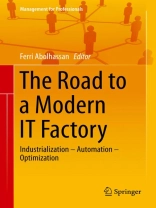IT is currently going through one of its most critical phases of transformation. IT vendors and IT service organizations are revolutionizing their production and service processes, adopting industrial practices. It is only through the consistent transformation into factory-like structures that quality, effectiveness and efficiency can be increased. By integrating professional concepts and methods taken from the context of industrial production, it is possible to meet functional and qualitative requirements from the departments and therefore from the end user. On top of that this new paradigm enables the implementation of optimal processes in the organization. An interdisciplinary team of authors addresses the current challenges for global IT services organizations and describes the process of IT industrialization. The transformation of the IT industry towards the model of an IT factory is the core theme of this book, which takes the latest findings from applied research, consulting and IT business practices and combines them into a consistent and innovative approach to IT services.
Mục lục
Part 1: Critical Factors for Successful Global IT Service Organizations.- Part 2: Industrial Reformation.- Part 3: Tools for Immediate Optimization and Greater Efficiency.- Part 4: Structural Changes.- Part 5: Innovation Ecosystem.- Part 6: A Route for Industrial IT Production.
Giới thiệu về tác giả
Dr. Ferri Abolhassan is Director of Production & Systems Integration at T-Systems International. He joined T-Systems in September 2008 and holds a doctorate in computer science. Dr. Abolhassan started his career in research and development in 1987 at Siemens in Munich. From 1989 to 1991 his work in the field of parallel computer architecture brought him to IBM in the United States. Between 1992 and 2001, Dr. Abolhassan held various management positions at SAP. As Senior Vice President of SAP’s global ‘Retail and Consumer Products’ business unit, he successfully developed and marketed SAP’s channel management solution in the retail sector.












